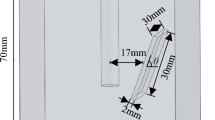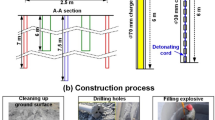Abstract
With the application of electronic detonators, millisecond blasting is regarded as a significant promising approach to improve the rock fragmentation in deep rock blasting. Thus, it is necessary to investigate the fracturing mechanisms of short-delay blasting. In this work, a rectangle model with two circle boreholes is modeled as a particles assembly based on the discrete element method to simulate the shock wave interactions induced by millisecond blasting. The rectangle model has a size of 12 × 6 m (L × W) and two blast holes have the same diameter of 12 cm. The shock waves are simplified as time-varying forces applied at the particles of walls of the two boreholes. Among a series of numerical tests in this study, the spacing between two adjacent boreholes and delay time of millisecond blasting are considered as two primary variables, and the decoupling charge with a coefficient of 1.5 is taken into account in each case. The results show that stress superposition is not a key factor for improving rock fragmentation (tensile stress interactions rather than compressive stress superposition could affect the generation of cracks), whereas collision actions from isolated particles or particles with weakened constraints play a crucial role in creating the fracture network. The delay time has an influence on causing cracks in rock blasting, however, whether it works heavily depends on the distance between the two holes.
Similar content being viewed by others
References
Chiappetta F (2010), “Combining Electronic Detonators with Stem Charges and Air Decks,” https://doi.org/www.iqpc.com/redForms.aspx?id=414254&sform_id=473344. Accessed 10 Aug., 2012.
Cho SH and Kaneko K (2004). “Rock Fragmentation Control in Blasting,” Materials Transactions, 45(5): 1722–1730.
Dohyun P, Byungkyu J and Seokwon (2009), “A Numerical Study on the Screening of Blast-Induced Waves for Reducing Ground Vibration,” Rock Mechanics and Rock Engineering, 42: 449–473.
Fakhimi A and Villegas T (2007), “Application of Dimensional Analysis in Calibration of a Discrete Element Model for Rock Deformation and Fracture,” Rock Mechanics and Rock Engineering, 40: 193–211.
Henrych J (1979), The Dynamics of Explosion and Its Use, New York: Elesvier Scientific Publishing Company.
Itasca Consulting Group Inc. (2015), “PFC2D-Particle Flow Code in Two Dimensions,” Ver. 5.0, User’s Manual. ICG, Minneapolis.
Johansson D and Ouchterlony F (2013), “Shock Wave Interactions in Rock Blasting: the Use of Short Delays to Improve Fragmentation in Model-Scale,” Rock Mechanics and Rock Engineering, 46: 1–18.
Park BK, Lee IM, Kim SG, Lee SD and Cho KH (2004), “Probabilistic Estimation of Fully Coupled Blasting Pressure Transmitted to Rock Mass. II: Estimation of Rise Time,” Tunnelling and Underground Space Technology, 6(1):25–39.
Rossmanith HP (2002), “The Use of Lagrange Diagrams in Precise Initiation Blasting, Part I: Two Interacting Blast Holes,” Fragblast: International Journal for Blasting and Fragmentation, 6(1): 104–136.
Rossmanith HP and Kouzniak N (2004), “Supersonic Detonation in Rock Mass: Part 2—Particle Displacements and Velocity Fields for Single and Multiple Non-Delayed and Delayed Detonating Blast Holes,” Fragblast: International Journal for Blasting and Fragmentation, 8(2): 95–117.
Sjöberg J, Schill M, Hilding D, Yi C, Nyberg U and Johansson D (2012), “Computer Simulations of Blasting with Precise Initiation,” In: Rock Engineering and Technology for Sustainable Underground Construction Proceedings, Eurock 2012 - ISRM international symposium, Stockholm, 28–30 May, 2012.
Vanbrabant F and Espinosa A (2006). “Impact of Short Delays Sequence on Fragmentation by Means of Electronic Detonators: Theoretical Concepts and Field Validation,” In: Fragblast 8, Proceedings of the 8th international symposium on rock fragmentation by blasting, Editec SA, Santiago, 326–331.
Wang T, Zhou W, Chen J, Xiao X, Li Y and Zhao X (2014), “Simulation of Hydraulic Fracturing Using Particle Flow Method and Application in a Coal Mine,” International Journal of Coal Geology, 121: 1–13.
Wang Wei, Li Xiaochun, Yuan Wei, Wang Qizhi and Li Guifeng (2016), “Model Test and Mechanism Study of the Blasting-Enhanced Permeability of Sandstone-Type Uranium Deposits of Low-Permeability,” Chinese Journal of Rock Mechanics and Engineering, 35(8): 1609–1617.
Yan Peng, Lu Wenbo, Zhang Jing, Zou Yujun and Chen Ming (2017), “Evaluation of Human Response to Blasting Vibration from Excavation of a Large Scale Rock Slope: A Case Study,” Earthquake Engineering and Engineering Vibration, 16(2): 435–446.
Yi Changping, Daniel Johansson, Ulf Nyberg and Ali Beyglou (2016), “Stress Save Interaction Between Two Adjacent Blast Holes,” Rock Mechanics and Rock Engineering, 49: 1803–1812.
Zhu WC, Gai D, Wei CH and Li SG (2016), “High-Pressure Air Blasting Experiments on Concrete and Implications for Enhanced Coal Gas Drainage,” Journal of Natural Gas Science and Engineering, 36: 1253–1263.
Zhu WC, Wei CH, Li S, Wei J and Zhang MS (2013), “Numerical Modeling on Destress Blasting in Coal Seam for Enhancing Gas Drainage,” International Journal of Rock Mechanics & Mining Sciences, 59: 179–190.
Acknowledgement
The authors gratefully acknowledge the support of the National Science Foundation for Young Scientists of China (No. 51709176), National Natural Science Foundation of China (No. 51979170), Hebei Province Natural Science Foundation for Yong Scientists (No. E2018210046), Open Project of State Key Laboratory of Advanced Electromagnetic Engineering and Technology (No. AEET 2019KF005) and Key Project of Hebei Natural Science Foundation (No. F2019210243).
Author information
Authors and Affiliations
Corresponding author
Additional information
Supported by: National Science Foundation for Young Scientists of China under Grant No. 51709176, National Natural Science Foundation of China under Grant No. 51979170, Key Project of Hebei Natural Science Foundation under Grant No. F2019210243, Hebei Province Science Foundation for Young Scientists under Grant No. E2018210046, Open Project of State Key Laboratory of Advanced Electromagnetic Engineering and Technology under Grant No. AEET 2019KF005.
Rights and permissions
About this article
Cite this article
Yuan, W., Liu, S., Wang, W. et al. Numerical study on the fracturing mechanism of shock wave interactions between two adjacent blast holes in deep rock blasting. Earthq. Eng. Eng. Vib. 18, 735–746 (2019). https://doi.org/10.1007/s11803-019-0533-6
Received:
Accepted:
Published:
Issue Date:
DOI: https://doi.org/10.1007/s11803-019-0533-6




